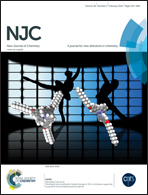Carbohydrates in the gas phase: conformational preference of d-ribose and 2-deoxy-d-ribose†
Abstract
A full exploration of the conformational landscape of D-ribose and 2-deoxy-D-ribose monosaccharides in the gas phase has been performed using DFT methods (B3LYP and M06-2X). Open-chain, furanose and pyranose configurations have been examined. Up to 954 and 668 stable structures have been obtained for D-ribose and 2-deoxy-D-ribose. Among these structures, up to 35 and 22 have relative energies smaller than 5 kJ mol−1 with respect to the absolute minimum of each molecule, respectively. For D-ribose, pyranose in α- and β-forms is the most populated according to both functionals, the β-diastereoisomer being the most populated. For 2-deoxy-D-ribose, the α-pyranose form is in majority. The β/α relationship of pyranose forms presents different results for both functionals: for M06-2X it increases in D-ribose and decreases in 2-deoxy-D-ribose at 0 K with respect to the room temperature results, the opposite case occurring in B3LYP. Intramolecular weak interactions have been characterized using the AIM and NBO methodologies.


 Please wait while we load your content...
Please wait while we load your content...